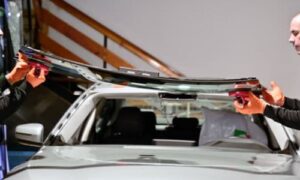How can mirrors prevent accidents? How to position your car’s side-view mirrors is a problem that doesn’t appear to have a good solution.
Drivers have been instructed to adjust them for years to see each vehicle’s back corners when appropriately seated behind the wheel.
The “rear corner viewing configuration” is ideal for backing into parking spots.
However, it has a severe drawback: It has blind spots.
Therefore, it is recommended that drivers check their blind spots before changing lanes or entering traffic by looking behind them.
Mirrors are regarded as safety equipment. However, while utilizing them in traffic, our focus must momentarily shift away from the front of the car.
It’s essential to glance over your shoulder to check your blind spots since rear-end collisions account for around 32% of all auto accidents.
However, this practice sometimes has unforeseen repercussions.
Active monitoring of blind spots
Some of the most recent models from automakers, including Volvo, Toyota, Audi, and Mazda, have blind-spot detection technology.
One or more electronic detecting sensors positioned on or close to the side-vision mirrors or rear bumper are standard components of an “active blind spot monitoring” system.
The gadgets emit electromagnetic waves (often in radar frequencies) or capture and analyze digitally processed pictures.
When other cars reach the back or side blind zones of equipped vehicles, they send notifications, such as a flashing light or loud sound.
Major automakers get their own active blind spot monitoring system, RSDS, from Delphi, a components supplier.
The RSDS, according to Delphi, allows drivers additional time to respond to impediments that could be difficult to spot in side-view mirrors.
Blind-spot recognition, lane change/merge assistance, a rear cross-traffic warning, and rear pre-crash sensing are a few of its features.
But do they outperform the passive side-view mirrors that generations of drivers have used?
Surprisingly, the response is no, by studies and polls done by periodicals in the automotive sector in 2012.
Active monitoring systems fail to increase the general safety of equipped cars, and some experts worry that relying too much on them might weaken the efficiency of a vehicle’s most crucial safety component: the airbags—a vigilant driver.
10 States with the Most Car Accidents in 2022 (insurify.com)
How to adjust the mirrors on your automobile
A 1995 study article from the Society of Automotive Engineers (SAE) describes a novel method for mirror alignment that seems to be gaining acceptance.
The SAE-recommended technique removes the blind areas at four and eight o’clock locations by lining up the rear-vision and side-vision mirrors.
You may set up mirrors in this manner using video tutorials that walk you through each step.
Here is a brief explanation:
- Sit upright in the driver’s seat and tilt your head to the driver’s window until it almost touches it. Then, set the driver’s side-view mirror so you can make out the car’s back corner.
- With your head at regular height, lean to the passenger side until it is about in line with the car’s centerline (between the two front seats). Next, adjust the passenger side view mirror so you can barely make out the opposite rear corner of the vehicle.
- Rotate the rearview mirror to point toward the middle of the back window.
- As you drive, you’ll notice that automobiles coming up from behind you will travel across your rearview mirror and suddenly appear in your side-view mirror. There could even be some overlap.
- Take note of how the side-view mirrors now provide a far more comprehensive picture of the car’s surroundings, eliminating the need to turn your head to check for oncoming traffic before merging or changing lanes.
Some detractors claim that this design limits the driver’s ability to see the back corners, increasing their risk of collisions while reversing.
But keep in mind: When you turn your head to either side, those corners are still discernible.
The safety of your loved ones is at risk since many reversing accidents occur in the driver’s garage or driveway.
Convex mirrors
Installing specialized convex mirrors in the corner of your car’s side-view mirrors, which provide you see into spaces that regular mirrors can’t, is another way to prevent blind spots.
The manufacturer may provide these convex mirrors, or you may purchase them from an automobile retailer and do the installation yourself (though it is recommended to have them fitted adequately since their placement is vital).
Installing a convex mirror hung in the driveway or garage may also significantly reduce the chance of a reversing disaster at home.
Convex mirrors are affordable and provide drivers with a 160-degree field of vision behind them when positioned carefully.
Convex or not, low-tech mirrors may be just as dependable as high-tech ones; it would appear. They are also less expensive.



